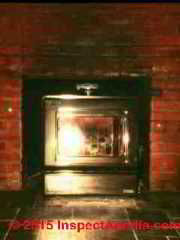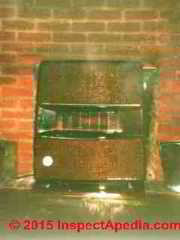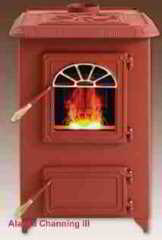 Coal Stove Installation & Operation
Coal Stove Installation & Operation
Coal stove controls & draft
- POST a QUESTION or COMMENT about dampers, fire/smoke dampers, duct dampers, vibration dampeners, or fire dampers or flue controls or HVAC duct controls
Coal Stove choices, installation, operation, & safety:
This article discusses the isntallation and operation of coal stoves used as heating appliances in buildings. We include details about heat output control and draft regulation.
The article links to additional details providing coal stove fire cleareances, chimney safety and coal stove sources, repairs, fuel costs, & related research.
InspectAPedia tolerates no conflicts of interest. We have no relationship with advertisers, products, or services discussed at this website.
- Daniel Friedman, Publisher/Editor/Author - See WHO ARE WE?
Coal stove dampers & draft control
Coal fueled heaters use manual dampers in the coal stove flue or for larger and automatically-fed coal fired boilers or furnaces the system may incorporate a thermostatically-operated automatic flue damper to control both draft and thus the system's heat output.
The coal stove shown at above left was installed by the author (DF) in the 1970's. A slider along the stove bottom permitted the user to adjust the air intake rate - a necessary combustion and heat control since the installation of this stove in front of a small fireplace gave no access room for a flue damper control.
The second fireplace-inserted heater at above right is a coal stove that was designed to also burn wood. This wood/coal heater, installed by Paul Galow in New York in the 1970's, also had a sliding air intake control and no accessible flue damper.
The vertical lines you see in the glass front of each of these coal burners allowed the installation of glass that would not fracture due to thermal expansion, allowing the occupants to enjoy watching the fire. Yes ultimately these get broken by a careless occupant or user, putting the stove out of use until the glass could be replaced.
Watch out: if the incoming combustion air cannot be shut down because of leaky coal stove gaskets or other damage like the broken glass in the coalstove door, the coal stove is unsafe as its burn-rate cannot be regulated.
See CHIMNEY FIRE ACTION / PREVENTION
Also see FIRE CLEARANCES WOOD & COAL STOVES
Reader Question: can I put to barometric dampers on the same flue along with a manual one on my Alaska Channing III Coal Stove?
I have a Alaska channing 111. My barometric damper is 6 in then [the flue vent connector goes to 8 in to connect ] to massonary chimney.
It seems I need two dampers. I installed a manual damper to help
My question is can I put 2 baro dampers in the same flue to control proper draft
Thanks, Bill
Reply:
Bill
The Alaska Channing III is a coal stove (shown at left) designed to burn rice coal and with a BTUh output of 5,000 to 85,000 BTUh. That heat output capacity is controlled in part by controlling the fire rate by controllinb combustion air.
Heat control for this coal stove is provided either by a manual control to adjust heat output (basically you're adjusting the input air flow rate), or by a wall-mounted thermostat system that operates in two heat output ranges (low fire and high fire).
As long as the single barometric damper is properly adjusted and capable of opening to permit enough air intake to keep the draft at the desired level it would be fine. If the damper were not capable, such as in an area of very high winds creating unusual drafts over a chimney top, the solution would probably include
Watch out: I infer from your question that you are getting too much heat or that the coal stove seems to be overheating. This condition can be unsafe and in fact in extreme cases (such as leaving the coal stove door ajar with a fire burning) you can warp and ruin the stove or even cause a house fire.
It should not be necessary to install two barometric dampers on a heating appliance unless you are facing very unusual draft control problems. Nothing I read about this coal stove suggests that it would suffer from excessive draft. In fact the company notes that power vents can be used with their equipment (creating a still-stronger draft) and that some models including the Channing III rear vent can be direct-vented (with no chimney).
Installing 2 dampers is not something I'd recommend as adjusting them would probably be difficult, adding complexity that should not be necessary. It's like adding complexity to try to solve a problem rather than understanding the problem first.
If your coal stove is overheating check these details
- Coal Stove Installation & Safety: Check that you have installed the stove according to the company's instructions. In most jurisdictions installing a coal stove requires a building permit, safety inspections, and of course compliance with combustion clearance and other safety guidelines.
- Coal Stove Fuel: Check that you are burning only the fuel recommended by the manufaturer. Your Channing III coal stove is designed to burn only pea-coal. If you are burning wood pellets the result is dangerous: a hopper fire. (The company does have a different stove model that can burn wood pellets).
- Coal Stove Operation & Openings: Check that the coal stove door or other openings are properly closed and that all gaskets are in place and not leaking. If you set combustion air inlet control(s) to their most-closed position and the stove fire does not slow accordingly then it's likely that there are air leaks into the stove and it should not be used.
- Coal Stove Heat Controls: Check that you have properly set the manual or thermostatically-controlled thermostat to control the heat output of the coal stove and confirm that the heat control is working. This means turn the heat control to its lowest setting. The fire should get very low or small. To completely turn off the a stove that uses a power vent it may also be necessary to un-plug or turn off the vent fan.
- If you are using the manual thermostat (the "Auto Heat Control Box") and you set temperature down check that indeed the coal fire slows (air input is reduced).
- If you are using the wall-mounted room thermostat system check that the air damper on the stove is responding to changes called for by the thermostat.
- Chimney connection for coal stove: You cannot safely share a chimney flue to which a coal stove is connected with other heating appliances. Doing so risks dangerous fire spread, carbon monoxide hazards, backdrafting and other operating problems as well as of course building code violations. Be sure that a properly designed chimney cap is on the top of the flue
- Coal Stove Draft Regulation: Install a single barometric damper on the larger diameter flue section as the company recommends.
The company does recommend the use of a barometric damper on the Alaska Channing III when it is connected to a chimney to overcome excess draft caused by site conditions such as wind, outdoor temperature changes and changes in barometric pressure (the least of these forces). Regulating the draft gives more complete combustion, more even heat output, and more efficient use of your coal fuel.
To obtain an installation & operation manual for your Alaska Channing III coal stove, contact the
- Alaska Stove Company, 3162 Columbia Blvd.
Bloomsburg, PA 17815
Tel: USA 570-387-0260
Website: www.alaskastove.com
Watch out: if the flue damper rusts or becomes damage it may be impossible to slow the chimney draft, resulting in an over-heating stove and possibly a chimney or house fire. Though questionable fire clearances and accumulated creosote may have been factors, just such a runaway wood stove fire and its disastrous results are illustrated
at CHIMNEY FIRES & WOOD STOVE SAFETY
...
Continue reading at FIRE CLEARANCES, WOOD COAL & PELLET STOVES or select a topic from the closely-related articles below, or see the complete ARTICLE INDEX.
Or see these
Recommended Articles
- CHIMNEY CODES for downloadable copies of common chimney and appliance venting codes and standards
- CHIMNEY CODES & STANDARDS - home
- CHIMNEY SAFETY, WOOD BURNING - CPSC
- COALSTOVE DRAFT CONTROL
- COAL STOVE OPERATION & SAFETY
- CREOSOTE DEPOSITS, FIRE HAZARD
- DRAFT INDUCER FANS
- FIRE CLEARANCES INDOORS
- FIRE CLEARANCES, WOOD COAL & PELLET STOVES
- PYROLYSIS EXPLAINED
- SHARED CHIMNEY & FLUE HAZARDS - home
- SHARED CHIMNEY FLUES OK
- WOOD-OIL COMBINATION HEATERS
- WOOD STOVE OPERATION & SAFETY
Suggested citation for this web page
COAL STOVE OPERATION & SAFETY at InspectApedia.com - online encyclopedia of building & environmental inspection, testing, diagnosis, repair, & problem prevention advice.
Or see this
Ask a Question or Search InspectApedia
Try the search box just below, or if you prefer, post a question or comment in the Comments box below and we will respond promptly.
Search the InspectApedia website
Note: appearance of your Comment below may be delayed: if your comment contains an image, photograph, web link, or text that looks to the software as if it might be a web link, your posting will appear after it has been approved by a moderator. Apologies for the delay.
Only one image can be added per comment but you can post as many comments, and therefore images, as you like.
You will not receive a notification when a response to your question has been posted.
Please bookmark this page to make it easy for you to check back for our response.
Our Comment Box is provided by Countable Web Productions countable.ca
Citations & References
In addition to any citations in the article above, a full list is available on request.
- Airflow Breeze air movement register booster fans are produced by AirFlow Technology, Airflow Technology 1427 West 86th Street, Suite 328 Indianapolis, IN 46260 1-800-458-5540 website: http://www.aftproducts.com/Airflow_Breeze_3ff0ef340c6e0e13b.dept
- Fuel Oil & Oil Heating Magazine, 3621 Hill Rd., Parsippany, NJ 07054, 973-331-9545 rk 3rd Ed 1969.
- National Fuel Gas Code (Z223.1) $16.00 and National Fuel Gas Code Handbook (Z223.2) $47.00 American Gas Association (A.G.A.), 1515 Wilson Boulevard, Arlington, VA 22209 also available from National Fire Protection Association, Batterymarch Park, Quincy, MA 02269. Fundamentals of Gas Appliance Venting and Ventilation, 1985, American Gas Association Laboratories, Engineering Services Department. American Gas Association, 1515 Wilson Boulevard, Arlington, VA 22209. Catalog #XHO585. Reprinted 1989.
- [1] "Instructions for Installing FIELD Type AF Barometric Draft Controls," Form No. 31 DC 30666, Field Corporation, Mendota, IL 61342, web search 04/02/2011, original source: http://www.fieldcontrols.com/pdfs/04592700.pdf, Field Controls, Kingston, North Carolina 28501, Tel: 919-522-3031
- [2] Tjernlund Draft Controls, A Series (single action for oil, solid fuel, and fan-assisted gas burners) and B Series (double action for gas heating appliances), web search 04/02/1011, original source: http://www.tjernlund.com/Tjernlund_8500490.pdf , Tjernlund Products, Inc., 1601 Ninth Street, White Bear Lake MN 55110-6794, Tel: 651-426-2993 or 800-255-4208 website: www.tjernlund.com Email: fanmail@tjfans.com
- Carbon Monoxide Gas Toxicity, exposure limits, poisoning symptoms, and inspecting buildings for CO hazards
- DUST, HVAC CONTAMINATION STUDY An Investigation of Indoor Dust Debris Blamed on a Heating/Cooling System Reveals Carpet Dust
- Fuel Oil & Oil Heating Magazine, 3621 Hill Rd., Parsippany, NJ 07054, 973-331-9545
- Goodman Furnace High Temperature Plastic Vent HTPV safety recall US CPSC notice
- Home Heating System Should Be Checked[for proper venting and for CO Carbon Monoxide Hazards - DJF]
- Inspection Procedures for Oil-Fired Heating Systems Detailed step by step approaches for inspecting complex systems]
- Lennox Pulse Furnace Safety Inspection/Warranty Program: Carbon Monoxide Warning
- Plastic Heating Vent Pipe & Other Heating Safety Recall Notices
- Weil McLain Model GV Gas Boiler/gas valve CPSC recall/repair
- Domestic and Commercial Oil Burners, Charles H. Burkhardt, McGraw Hill Book Company, New York 3rd Ed 1969.
- National Fuel Gas Code (Z223.1) $16.00 and National Fuel Gas Code Handbook (Z223.2) $47.00 American Gas Association (A.G.A.), 1515 Wilson Boulevard, Arlington, VA 22209 also available from National Fire Protection Association, Batterymarch Park, Quincy, MA 02269. Fundamentals of Gas Appliance Venting and Ventilation, 1985, American Gas Association Laboratories, Engineering Services Department. American Gas Association, 1515 Wilson Boulevard, Arlington, VA 22209. Catalog #XHO585. Reprinted 1989.
- The Steam Book, 1984, Training and Education Department, Fluid Handling Division, ITT [probably out of print, possibly available from several home inspection supply companies] Fuel Oil and Oil Heat Magazine, October 1990, offers an update,
- Principles of Steam Heating, $13.25 includes postage. Fuel oil & Oil Heat Magazine, 389 Passaic Ave., Fairfield, NJ 07004.
- The Lost Art of Steam Heating, Dan Holohan, 516-579-3046 FAX
- Principles of Steam Heating, Dan Holohan, technical editor of Fuel Oil and Oil Heat magazine, 389 Passaic Ave., Fairfield, NJ 07004 ($12.+1.25 postage/handling).
- "Residential Steam Heating Systems", Instructional Technologies Institute, Inc., 145 "D" Grassy Plain St., Bethel, CT 06801 800/227-1663 [home inspection training material] 1987
- "Residential Hydronic (circulating hot water) Heating Systems", Instructional Technologies Institute, Inc., 145 "D" Grassy Plain St., Bethel, CT 06801 800/227-1663 [home inspection training material] 1987
- "Warm Air Heating Systems". Instructional Technologies Institute, Inc., 145 "D" Grassy Plain St., Bethel, CT 06801 800/227-1663 [home inspection training material] 1987
- Heating, Ventilating, and Air Conditioning Volume I, Heating Fundamentals,
- Boilers, Boiler Conversions, James E. Brumbaugh, ISBN 0-672-23389-4 (v. 1) Volume II, Oil, Gas, and Coal Burners, Controls, Ducts, Piping, Valves, James E. Brumbaugh, ISBN 0-672-23390-7 (v. 2) Volume III, Radiant Heating, Water Heaters, Ventilation, Air Conditioning, Heat Pumps, Air Cleaners, James E. Brumbaugh, ISBN 0-672-23383-5 (v. 3) or ISBN 0-672-23380-0 (set) Special Sales Director, Macmillan Publishing Co., 866 Third Ave., New York, NY 10022. Macmillan Publishing Co., NY
- Installation Guide for Residential Hydronic Heating Systems
- Our recommended books about building & mechanical systems design, inspection, problem diagnosis, and repair, and about indoor environment and IAQ testing, diagnosis, and cleanup are at the InspectAPedia Bookstore. Also see our Book Reviews - InspectAPedia.
- In addition to citations & references found in this article, see the research citations given at the end of the related articles found at our suggested
CONTINUE READING or RECOMMENDED ARTICLES.
- Carson, Dunlop & Associates Ltd., 120 Carlton Street Suite 407, Toronto ON M5A 4K2. Tel: (416) 964-9415 1-800-268-7070 Email: info@carsondunlop.com. Alan Carson is a past president of ASHI, the American Society of Home Inspectors.
Thanks to Alan Carson and Bob Dunlop, for permission for InspectAPedia to use text excerpts from The HOME REFERENCE BOOK - the Encyclopedia of Homes and to use illustrations from The ILLUSTRATED HOME .
Carson Dunlop Associates provides extensive home inspection education and report writing material. In gratitude we provide links to tsome Carson Dunlop Associates products and services.



